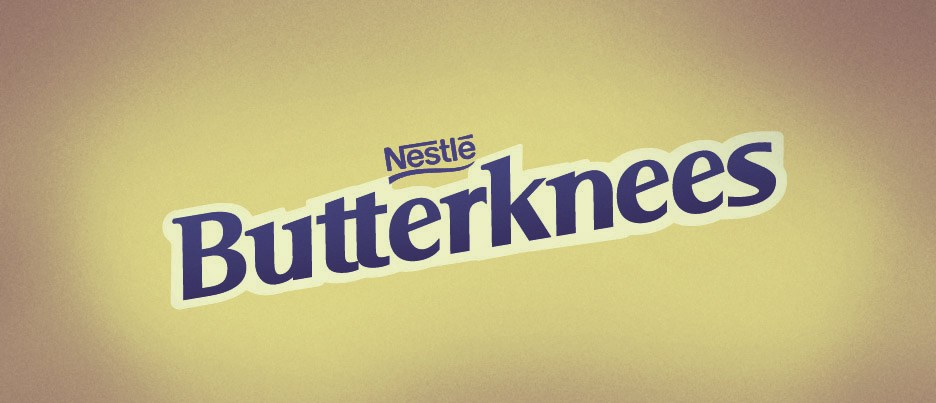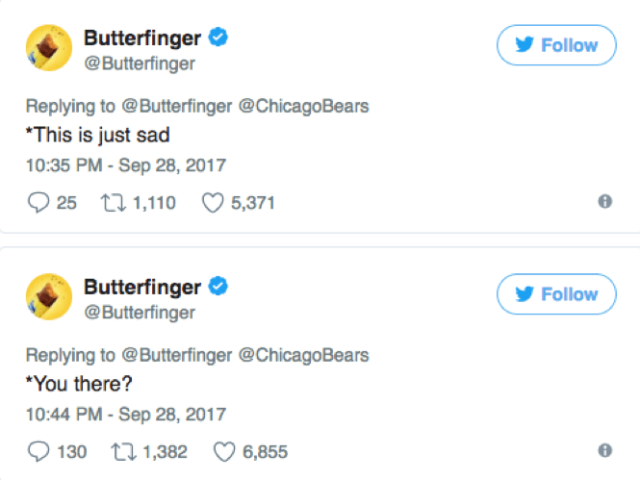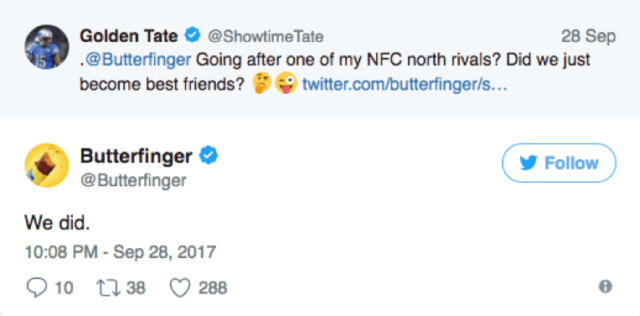Butterfinger Batters Bears on Thursday Night Twitter

The Chicago Bears’ 35-14 trouncing by the Packers wasn’t their only embarrassing, real-time loss on a national media outlet last Thursday. They were also manhandled on Twitter … by the Butterfinger candy brand.
The action began in the first quarter, when Bears quarterback Mike Glennon lost a snap off his knee for a fumble that the Packers recovered. Somewhat predictably, the candy’s Twitter account trolled the Bears with a “butterfingers” pun.

The Bears, apparently offended by the tweet, responded humorlessly.

For Butterfinger, that was like waving a red flag in front of a bull, particularly given the Bears’ continuing futility on the field.

Rather than backing down, the Bears then (somewhat weirdly) replied with a song –
“Attention” by Charlie Puth. That backfired, as the Bears continued to dig a hole for themselves. At 21-0, the rout was on … online and off.

Even when the game was well out of hand in the second half, Butterfinger kept running up the score.

While the Butterfinger/Bears Twitter brawl had been getting plenty of attention on its own, the ante upped even further when Detroit Lions wide receiver Golden Tate piled on.

So what is the takeaway from all of this? There are probably several, beginning with the widespread admonition: Don’t feed the trolls.
“Trolls want attention,” warns Forbes magazine. “They want to get you angry, frustrated or uncomfortable. No matter how difficult it might be, simply ignoring a troll could be your best tactic because when they don’t get a response, they’ll most likely go away.”
Obviously there are times you can’t ignore trolls, particularly if they are spreading false information. In that situation, you should set the record straight immediately.
That wasn’t case last Thursday, however – the Bears were stinking it up, period. If a brand or spokesperson does choose to engage with trolls understand that you a) are playing with fire; and b) better be ready with a quick wit and a solid understanding of the larger context the contretemps could be viewed in. Twitter might be one of the least advisable fields of play, because of users’ expectations of rapid response and the amount of bile and viciousness it has become infamous for. Should you still choose to respond, try using humor. Imagine the direction the Butterfinger conversation could have gone in if the Bears had responded with a joke back … rather than a finger-wagging admonition worthy of a Catholic School nun in front of a 3rd grade class.
Certainly, many brands have figured out how to turn brand-on-brand trolling into a positive, which can result in humorous social media posts that are widely shared.Still, brands should take caution, as noted by Clare Groombridge in Fast Company.
“It’s important to remember that in the vast majority of cases they are large, international brands such as Amazon, Mercedes, Jaguar, and Nokia,” she says. “Each with a dedicated, qualified social media team who will have spent time evaluating the impact and potential ramifications of their posts.”
Smaller brands without the resources and time to evaluate the tone and wording of off-the-cuff responses should avoid a spur-of-the-moment battle. A post that’s clever and witty to one person could be tone deaf and offensive to the next.
B+L’s advice regarding trolls is the same as that of Groombridge and many other social media consultants: if you aren’t sure about it, don’t do it. There are just too many ways to fumble that football.

